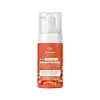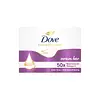Fresh Skinlab Tomato Glass Skin 3 In 1 Vitamin C Brightening Foam Cleanser Versus Dove Radiant+Care Serum Bar With Niacinamide + Omega 6
What's inside
What's inside
 Key Ingredients
Key Ingredients

 Benefits
Benefits

 Concerns
Concerns

 Ingredients Side-by-side
Ingredients Side-by-side

Water
Skin ConditioningCocamidopropyl Betaine
CleansingButylene Glycol
HumectantMethyl Gluceth-20
HumectantHyaluronic Acid
HumectantHydrolyzed Collagen
EmollientPEG-60 Hydrogenated Castor Oil
EmulsifyingSolanum Lycopersicum Fruit Extract
AntioxidantCentella Asiatica Extract
CleansingPhenoxyethanol
PreservativeParfum
MaskingAllantoin
Skin ConditioningChlorphenesin
AntimicrobialPEG-12 Dimethicone
Skin ConditioningMelaleuca Alternifolia Leaf Extract
PerfumingVitis Vinifera Fruit Extract
Skin ConditioningHamamelis Virginiana Leaf Extract
Skin ConditioningCitric Acid
BufferingGlycyrrhiza Glabra Root Extract
BleachingMorus Alba Bark Extract
Skin ConditioningArbutin
AntioxidantDisodium EDTA
Portulaca Oleracea Extract
Skin ConditioningHydrolyzed Hyaluronic Acid
HumectantAscorbyl Glucoside
AntioxidantAscorbic Acid
AntioxidantWater, Cocamidopropyl Betaine, Butylene Glycol, Methyl Gluceth-20, Hyaluronic Acid, Hydrolyzed Collagen, PEG-60 Hydrogenated Castor Oil, Solanum Lycopersicum Fruit Extract, Centella Asiatica Extract, Phenoxyethanol, Parfum, Allantoin, Chlorphenesin, PEG-12 Dimethicone, Melaleuca Alternifolia Leaf Extract, Vitis Vinifera Fruit Extract, Hamamelis Virginiana Leaf Extract, Citric Acid, Glycyrrhiza Glabra Root Extract, Morus Alba Bark Extract, Arbutin, Disodium EDTA, Portulaca Oleracea Extract, Hydrolyzed Hyaluronic Acid, Ascorbyl Glucoside, Ascorbic Acid
Sodium Lauroyl Isethionate
CleansingStearic Acid
CleansingLauric Acid
CleansingSodium Palmate
CleansingWater
Skin ConditioningSodium Isethionate
CleansingSodium Stearate
CleansingCocamidopropyl Betaine
CleansingParfum
MaskingSodium Palm Kernelate
CleansingSodium Chloride
MaskingPropylene Glycol
HumectantZinc Oxide
Cosmetic ColorantNiacinamide
SmoothingTitanium Dioxide
Cosmetic ColorantGlycerin
HumectantSodium Benzoate
MaskingTetrasodium Etidronate
Emulsion StabilisingTetrasodium EDTA
Helianthus Annuus Seed Oil
EmollientAlumina
AbrasivePaeonia Officinalis Flower Extract
TonicPotassium Sorbate
PreservativeCitric Acid
BufferingCI 14700
Cosmetic ColorantCI 60730
Cosmetic ColorantSodium Lauroyl Isethionate, Stearic Acid, Lauric Acid, Sodium Palmate, Water, Sodium Isethionate, Sodium Stearate, Cocamidopropyl Betaine, Parfum, Sodium Palm Kernelate, Sodium Chloride, Propylene Glycol, Zinc Oxide, Niacinamide, Titanium Dioxide, Glycerin, Sodium Benzoate, Tetrasodium Etidronate, Tetrasodium EDTA, Helianthus Annuus Seed Oil, Alumina, Paeonia Officinalis Flower Extract, Potassium Sorbate, Citric Acid, CI 14700, CI 60730
Ingredients Explained
These ingredients are found in both products.
Ingredients higher up in an ingredient list are typically present in a larger amount.
Citric Acid is an alpha hydroxy acid (AHA) naturally found in citrus fruits like oranges, lemons, and limes.
Like other AHAs, citric acid can exfoliate skin by breaking down the bonds that hold dead skin cells together. This helps reveal smoother and brighter skin underneath.
However, this exfoliating effect only happens at high concentrations (20%) which can be hard to find in cosmetic products.
Due to this, citric acid is usually included in small amounts as a pH adjuster. This helps keep products slightly more acidic and compatible with skin's natural pH.
In skincare formulas, citric acid can:
While it can provide some skin benefits, research shows lactic acid and glycolic acid are generally more effective and less irritating exfoliants.
Most citric acid used in skincare today is made by fermenting sugars (usually from molasses). This synthetic version is identical to the natural citrus form but easier to stabilize and use in formulations.
Read more about some other popular AHA's here:
Learn more about Citric AcidCocamidopropyl Betaine is a fatty acid created by mixing similar compounds in coconut oil and dimethylaminopropylamine, a compound with two amino groups.
This ingredient is a surfactant and cleanser. It helps gather the dirt, pollutants, and other impurities in your skin to be washed away. It also helps thicken a product and make the texture more creamy.
Being created from coconut oil means Cocamidopropyl Betaine is hydrating for the skin.
While Cocamidopropyl Betaine was believed to be an allergen, a study from 2012 disproved this. It found two compounds in unpure Cocamidopropyl Betaine to be the irritants: aminoamide and 3-dimethylaminopropylamine. High-grade and pure Cocamidopropyl Betaine did not induce allergic reactions during this study.
Learn more about Cocamidopropyl BetaineParfum is a catch-all term for an ingredient or more that is used to give a scent to products.
Also called "fragrance", this ingredient can be a blend of hundreds of chemicals or plant oils. This means every product with "fragrance" or "parfum" in the ingredients list is a different mixture.
For instance, Habanolide is a proprietary trade name for a specific aroma chemical. When used as a fragrance ingredient in cosmetics, most aroma chemicals fall under the broad labeling category of “FRAGRANCE” or “PARFUM” according to EU and US regulations.
The term 'parfum' or 'fragrance' is not regulated in many countries. In many cases, it is up to the brand to define this term.
For instance, many brands choose to label themselves as "fragrance-free" because they are not using synthetic fragrances. However, their products may still contain ingredients such as essential oils that are considered a fragrance by INCI standards.
One example is Calendula flower extract. Calendula is an essential oil that still imparts a scent or 'fragrance'.
Depending on the blend, the ingredients in the mixture can cause allergies and sensitivities on the skin. Some ingredients that are known EU allergens include linalool and citronellol.
Parfum can also be used to mask or cover an unpleasant scent.
The bottom line is: not all fragrances/parfum/ingredients are created equally. If you are worried about fragrances, we recommend taking a closer look at an ingredient. And of course, we always recommend speaking with a professional.
Learn more about ParfumWater. It's the most common cosmetic ingredient of all. You'll usually see it at the top of ingredient lists, meaning that it makes up the largest part of the product.
So why is it so popular? Water most often acts as a solvent - this means that it helps dissolve other ingredients into the formulation.
You'll also recognize water as that liquid we all need to stay alive. If you see this, drink a glass of water. Stay hydrated!
Learn more about Water